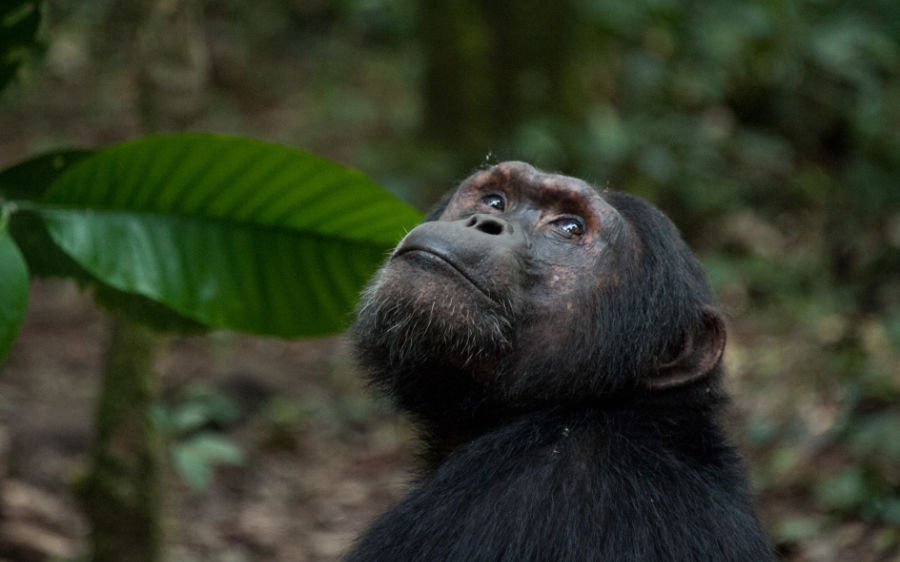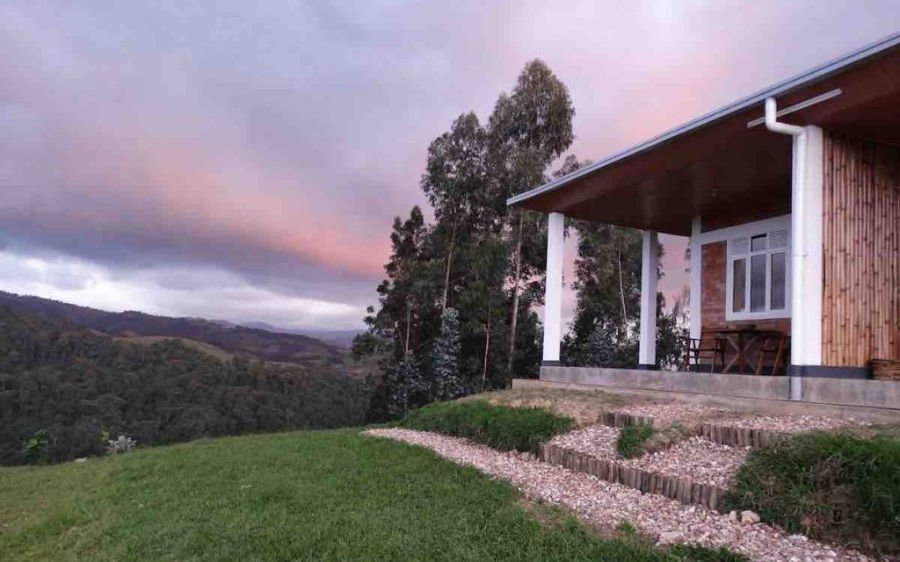Gishwati-Mukura National Park was created in 2015 with the goal of reversing the negative effects of illegal mining and encroachment by planting more trees to boost soil fertility, stabilise slopes, and control stream flow. It is Rwanda’s fourth national park and is comprised of two forests: the larger Gishwati and the smaller Mukura, with a combined area of 34 square kilometres (not including the buffer zone). The two forests are located in the western region of the nation along the extraordinarily biodiverse Albertine Rift, which forms a ridge separating the Congo Nile water catchment basins.
Conservation Efforts for Gishwati-Mukura National Park
Chimpanzees, together with golden monkeys, L’Hoest’s monkeys, and blue monkeys, call Gishwati home. Gishwati forest area has 232 bird species and Mukura has 163, including several forest specialists and endemics to the Albertine Rift.
This tiny population of isolated chimpanzees in Rwanda’s newest national park serve as a laboratory for the development of innovative conservation strategies. In 2008, there were just 13 individuals left of the whole chimpanzee population, and they were almost extinct. With the help of the government of Rwanda and the Gishwati Area Conservation Program, the population expanded by 46 per cent, from 13 in 2008 to 19 in 2011. There are now about 30 Chimpanzees in the forest. Great apes all around the globe may benefit greatly from efforts similar to those created to aid Gishwati’s great apes.
Thousands of Rwandans rely on the Gishwati forest for their survival. The forest cover protects the topsoil and helps keep its fertility stable. The area’s rich biodiversity has the potential to attract eco-tourists, which would be good for the Rwandan economy in the long run.
Biodiversity in Gishwati and Mukura forests
An extinction rate of 99.7% has occurred in the realm of fauna alone. The native people’s dependence on the local flora has also declined dramatically. The native population’s access to wild foods like fruits and vegetables has decreased by 99.6% and the availability of wild medicines has dropped by 79.5%. The forest has increased by 67%.
Flora in the Park
Over 60 species of trees may be found here, comprising of indigenous hardwood and bamboo, ferns, Macaranga kilimand, mahogany, and orchids. Some of the plant species that can be found in Giswati-Mukura National Park include:
- Trees: The park is home to a variety of tree species, including Eucalyptus, pine, olive, and acacia, Macaranga kilimandscharica, Carapa grandiflora, Entandrophagrama excelsum, and Symphonia globulifera are colonising parts of the forest that have been disturbed in the past but are now regenerating.
- Shrubs: Shrub species found in the park include Hypericum, Senecio, and Phylica.
- Herbs: A range of herb species can be found in the park, including Helichrysum, Lobelia, and Geranium.
- Grasses: The park is home to several grass species, including Heteropogon, Pennisetum, and Panicum.
New species added by the park officials include dombeya torrida, eucalyptus, hagenia abyssinica, macaranga, and polyscias fulva. Large tree ferns and blue lichen are two other types of plant life found in the preserve.
Fauna in the park
Within the reserve, you can find numerous species of fauna. The Eastern Chimpanzee (Pan troglodytes schweinfurtii), the golden monkey, the blue monkey, and the L’Hoest’s monkey are the four the primate species found there. Though not since 2002, a fifth species of primate, the black and white colobus monkey, has been reported. Twenty East African chimpanzees roam the forest now, according to estimates. From a starting population of 13 chimpanzees in 2008, when the GACP was first established, the population has grown by 54 percent.
Other mammals found in Africa include the African golden cat (Felis silvestris), serval (Leptailurus serval), southern tree hyrax (Dendrohyrax arboreus), black-fronted duiker (Cephalophus nigrifrons), and red river hog (Potamochoerus porcus) (Caracal aurata).
There are also 84 different species of birds, including the white-headed wood hoopoe (Phoeniculus bollei) and the mountain yellow warbler (Iduna similis).
Some of the amphibians that call the forest home include brown forest frogs, several types of toads, and a few lizards. The Gishwati Forest is home to several reptile species including the Albertine Endemic Great Lakes Bush Viper Atheris nitschei
Tourism Activities in Gishwati-Mukura National Park
Tourist activities in the park began in 2019, and they include guided nature hikes, chimpanzee and monkey tracking, bird viewing, and trips to the waterfalls.
There are two concessions in the national park made of the forest of Gishwati and the smaller Mukura forest.
The Rwanda Development Board, Wilderness Safaris, and Forest of Hope Association(FHA) all contribute to the management of the Gishwati Forest Concession.
All of Rwanda’s national parks are under the purview of the Rwanda Development Board. Gishwati Forest’s replanting and conservation efforts are being overseen by Forest of Hope, while Wilderness Safaris is in charge of the park’s tourist operations. The Mukura Forest is still off-limits to the public, while the Gishwati Forest welcomed its first visitors on December 1, 2020.
Chimpanzee trekking

Chimpanzee trekking is the most popular activity in Gishwati Forest, although visitors may also observe Golden Monkeys, serval cats, and other creatures. When the year 2020 rolled around, the Forest of Hope Guest House welcomed its first guests. If you want to see Gishwati Forest National Park, you have to stay in the guest house.
The Rwanda Development Board provides guides, and people from the surrounding villages offer their services as animal trackers.
Those planning to visit the park are required to obtain the appropriate permits in advance. A chimpanzee monitoring licence will cost you $100 beginning in 2021.
Gishwati Forest is a good place to go for chimpanzee trekking when you visit Rwanda. The Forest of Hope Guest House is where you’ll need to stay for this activity since it begins bright and early in the morning. It is estimated that there are now over 20 chimpanzees living in Gishwati Forest. Although chimpanzee tracking is possible here, unlike in Nyungwe forest national park or Cyamudongo Forest, the chimps are not habituated to people, making it more challenging.
Hiking and Nature walks
Gishwati Forest is home to three separate hiking routes. The 8-kilometre-long Umushwati Trail winds directly through the forest. In the vicinity of the Forest of Hope Guest House, you’ll find the beginning of the 7-kilometer-long Waterfall route. The Matyazo Hill Trail is a 3 km loop that may be done in conjunction with the Umushwati Trail, taking you to the park’s highest point at 2469 m.
Cultural encounters in Gishwati-Mukura National Park
- Visiting local markets: Many local communities in the area around the park have weekly markets where farmers and other local producers sell their products. Visiting these markets can be a great way to learn about local agriculture and food traditions, and you may be able to try some local dishes or purchase souvenirs.
- Participating in cultural activities: Some local communities offer cultural activities such as traditional dancing or music performances, which visitors can participate in or watch. These activities can be a great way to learn more about the culture and traditions of the area.
- Homestays: Some local communities offer homestays, where visitors can stay with a local family and experience life in the community. Homestays can be a great way to learn about local customs and traditions and to get to know the people who live in the area.
Climate and Weather in Gishwati-Mukura National Park?
In close proximity to the equator, Rwanda has a warm and humid subtropical climate. Located in the western Kivu Belt, where it gets more precipitation than the country’s more central and eastern regions, lies Gishwati-Mukura National Park. This is where the country’s tropical rainforests are located. Gishwati-Mukura National Park is located in the tropics, but because of its height, the weather is almost always mild and pleasant, averaging 25 degrees Celsius during the day and 15 to 20 degrees Celsius at night.
Rainy season
Though precipitation occurs at all times of the year, the Kivu Belt has two rainy seasons, one longer and one shorter. March through May is the heaviest rainy period. Heavy rain and thunderstorms are commonplace at this time of year, and some days may be entirely cloudy, although sporadic bright sunlight is sometimes possible. Rainfall is lower but more intense during the shorter rainy season (October–December). Even during the wetter months, it is not uncommon for the morning to be clear, with the clouds building during the day and eventually bringing rain in the evening.
Short Drought
While brief afternoon thunderstorms are not uncommon during the transitional time between the rainy seasons in January and February, it is also not uncommon for this period to go without precipitation for many days. Less precipitation falls during this season, making it an ideal time to go, and less people travel there, too, resulting in cheaper hotel and lodge rates.
Long drought
The Kivu Belt has the lowest rainfall in the summer months of June, July, and August. Even though it’s the dry season, you may still anticipate the occasional afternoon thunderstorm. This is the peak tourist season, yet it also happens to be the greatest time to visit. This time of year coincides with the high season for tourism in the Kivu Belt, since it is the vacation season in Rwanda. These peak seasons tend to see higher occupancy rates at hotels and theme parks.
Accommodation options
Two separate twin rooms, each with its own private bathroom, are available at the inn, and camping is also an option. Every meal of the day may be enjoyed here since the restaurant is open for breakfast, lunch, and supper. On a hillside with a view of the woods, you’ll find the cosy guesthouse. Since 2019 Gishwati Forest has become a national park, and all visitors must be accompanied by a guide at all times.
How to get to Gishwati-Mukura National Park
The Gishwati forest is conveniently located next to the major road connecting Rubavu and Karongi. Primate sightings on the highway are not uncommon. Visitors to Rwanda can get to the park office from Rubavu, you may take a bus, although it is not suggested that you use a cab, bike, or minivan. You’ll find the park’s headquarters on the main road just beyond the Gishwati Forest gate in the section of the park that’s closest to Rubavu. The park headquarters is located in a gated facility with blue roofs on the edge of the forest, overlooking the tea plantations of Pfunda, and is visible from the main road leading in from Rubavu.
From Kigali
To get to Gishwati Forest from Kigali quickly, take the RN4 through Musanze and on to Rubavu. About 15 minutes before reaching Rubavu, you will come to a junction beside the Pfunda Tea Factory. Take a left here to go toward Karongi.
Just keep going in the direction of Karongi for the next half an hour or more. On your right, just before entering Gishwati forest, is the blue park office complex. The full trip, including stops, is estimated to take 3.5–4 hours.
From Karongi
Proceed on the main road that leads to Rubavu. Gishwati Forest is on a major road. On your way out of the forest and into the Pfunda Tea Plantations, you’ll pass a blue-roofed office complex known as a blue park. Without any stops, the journey should take no more than two hours.
Best time to visit the Park
The best time to visit depends on your interests and the type of activities you would like to do. Here are a few factors to consider when planning your visit:
- Weather: Mukura-Gishwati has better weather than the Volcanoes National Park; year-round temperatures in this park range from approximately 20°C (68°F) to 30°C (86°F), with humidity levels often around 80%. March through May and September through November are considered the rainy seasons. You may opt to go during the dry season if you like drier weather (June to August and December to February). This is also the best time for bird watching.
- Wildlife viewing: The park is home to a variety of animals, including gorillas, chimpanzees, elephants, and many other species. If you are interested in seeing these animals, you may want to visit during the dry season, when the vegetation is thinner and it is easier to spot wildlife.
- Cultural activities: The park is located near several local communities, and you may be able to participate in cultural activities or visit local markets and villages during your visit. Visit traditional healers and learn their ways of collecting and processing of traditional herbs.
Accommodation Facilities in and outside the park

There are a variety of accommodation options available both within and around the park.
Within the park, there are a few options for accommodations, including:
- Gishwati Lodge: This lodge is located within the park and offers a variety of rooms and cottages, as well as a restaurant, bar, and outdoor pool. With six opulent chalets the lodge can accommodate a maximum of 15 people at once, it provides solitude and was constructed with breathtaking park views.
- Gishwati Campsite: This campsite is located within the park and offers basic facilities for visitors who want to camp.
- Forest of Hope Guest House: This does not provide any food or other services to its visitors. There are flush toilets and showers, a fireplace, a barbecue grill, and running water for household chores and cooking.
Around the park, there are several options for accommodations, including:
- Hotels: There are a few hotels located in the surrounding area, offering a range of amenities and services.
- Guesthouses: There are also several guesthouses located in the surrounding area, offering more basic accommodations at a lower price point.
- Homestays: Some local communities offer homestays, where visitors can stay with a local family and experience life in the community.




